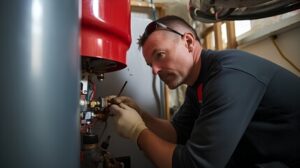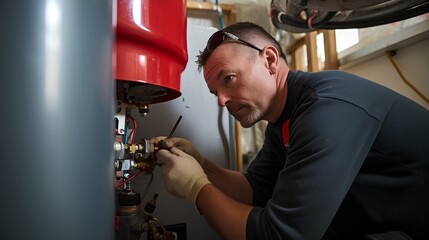Water Heater Denver is one of the most used appliances in a home. These traditional heaters come in many sizes with an insulated tank and can be powered by gas, electricity, or propane.
ENERGY STAR-certified models are available that use less energy to operate. They also work well with solar energy.
Tank water heaters are the most common type in Canadian homes and use an insulated tank to hold up to 80 gallons of hot water. They can be powered by electricity, gas or propane, depending on your home’s fuel source.
When the tank’s thermostat drops below a set temperature, the heating mechanism kicks in and heats the water to the desired setting. The cold water entering your home’s main line splits and passes through the dip tube before making its way into the tank. As the heating mechanism works, it recirculates the hot water through the bottom of the tank. The heated water then flows out your home’s hot-water supply pipes as needed.
If you have a family with a lot of hot water needs, your tank can fill up quickly. The dwindling supply of hot water is replenished when more is called for at a sink or bathtub, but as the demand for hot water rises, your tank’s capacity can be reached and you may run out of steam during the busiest hour.
Most tanks have a pressure relief valve that protects against overflow and a drain valve that allows you to empty the tank more easily. It’s also a good idea to perform preventative maintenance on your tank every year, especially in the fall and winter, to remove natural sediment and minerals that build up inside the bottom of the tank. A qualified technician can help you schedule an annual service that includes a professional cleaning and inspection of the pressure relief valve, drain valve and anode rod.
The size and location of your hot water heater should be carefully considered, as it can affect your energy usage. A large heater will be more expensive upfront and costs more to operate, while a smaller unit can save you money on your utility bills. A water heater technician can help you determine which type is right for your home. They’ll look at the size of your home, its energy efficiency rating and your household’s hot water requirements to recommend the perfect model for your needs.
Thermostat
From showering to washing laundry, to cooking and cleaning the house, we depend on hot water to help us function in our daily lives. Water heaters are one of the most common household appliances, and they are also among the biggest energy users in a home. A high-efficiency model can cut down on energy costs.
The thermostat on a water heater monitors the temperature inside the tank and controls the heating mechanism. Cold (but soon-to-be-hot) water enters your house’s main water line, then it passes through a dip tube and into the water heater. Hot water rises from the bottom of the tank, and if the thermostat is turned up the heater turns on and heats the water to the desired temperature. The hottest water then exits through the heat-out pipe located near the top of the tank.
There are two basic kinds of water heater thermostats – mercury switch and electronic. Mercury switches are old and inefficient, while digital thermostats are more efficient. Digital thermostats use a device called a thermistor to sense the temperature and convert the resulting varying resistance into an electrical signal. This type of thermostat tends to be programmable, while mercury switches are not.
Both types of water heater thermostats can be upgraded to newer models that will save energy and money. Some upgrades are simple – adding insulation, for instance – while others require professional installation. The simplest upgrade is to convert from the traditional gas pilot light to an electronic ignition system, which is more efficient and safer.
Another improvement is to install a district heating system that uses waste heat from electricity generation and other industries to provide hot water for homes, reducing the need for fossil fuels and high energy-value electric power to heat your water. This is also an important step to becoming green and lowering carbon emissions. In addition, you can also reduce your energy bills by using solar panels to provide your own electricity. You can even go one step further and use the excess electricity you generate to run electric appliances, thereby reducing your dependence on fossil fuels and the electricity grid.
Drain Valve
A water heater tank has 3 pipes: one to bring cold water in, one to move hot water out, and the drain valve. Located at the bottom of the exterior housing, the drain valve makes it easy to empty the water heater tank to replace the heating elements, remove sediment, or move the unit.
Keeping a water heater tank clean is essential to maintaining the integrity of the tank and its components. Mineral scale and other contaminants can build up inside the tank, reducing its effectiveness and leading to irreparable damage over time. When these minerals and sediments accumulate, they need to be drained on a regular basis. Water heater tanks have a built-in, self-closing drain valve to help keep these contaminants away from the heating elements.
Air compressor drain valves are used to remove contaminants and condensation from air systems on a regular basis. They can be triggered manually or automatically, and they come in various types. Choosing the right drain valve type depends on your needs and equipment. There are different thread sizes, materials, opening mechanism, fluid types and whether or not they have a locking mechanism.
In most cases, a drain valve is operated using an electric solenoid. The solenoid is controlled by an electrical signal that is triggered by the presence of liquid in the valve. It then raises or lowers a flow-blocking gate to open or close the passage through the valve body. Depending on the design of the valve, the gate may be in the form of a disk or a ball.
There are also float drains that operate by means of a float. These are triggered by the accumulation of moisture in the tank, but they can become fouled with debris and cause clogging. In addition, a float-operated drain can lead to compressed air loss while it is draining. For these reasons, a zero-loss air compressor drain valve is the best choice for most applications. It uses a sensor probe to detect the presence of water, and it opens the drain at a pre-determined rate, balancing drainage against compressed air loss.
Shut-Off Valve
The water heater may seem like a simple box-shaped appliance, but it hides a remarkable design on the inside. Its many parts work together to bring us hot running water for showering, washing laundry and dishes, cooking and cleaning. The majority of homes use tank-type water heaters, either gas or electric. Both operate on the same basic principle, with three pipes for water transfer: one to bring cold water in, a heat-out pipe suspended at the top of the tank, and a safety valve that releases pressure if the temperature or pressure becomes dangerously high.
A dip tube carries the cold water into the bottom of the tank, where a heating mechanism (electric water heaters have heating elements, while gas water heaters have a burner and chimney system) heats the water as per your thermostat setting. The heated water rises through the heat-out pipe at the top of the tank to your hot water service line on demand. A drain valve near the bottom allows you to remove sediment from the tank as needed.

